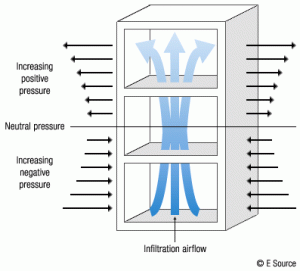I’m writing this blog post at the request of our office manager, Lisa. There was a day last week where we had THREE (3) houses with open windows when we arrived to pick up our short-term radon monitors. Three of ’em. In each case, the homeowners had opened the windows because their agent had supposedly told them that only the basement windows needed to be closed… which is simply not true. When performing a short-term radon test, ALL of the windows in a home need to be closed, per EPA protocol for short-term radon testing.
If the basement of a home was a completely airtight environment, and no air from the basement was allowed to communicate with the air in the upper levels, then it would be acceptable to open windows at the first and second floor while conducting a radon test in the basement. The only problem is that this is never, ever the case.
When the windows at upper levels are opened, the short-term radon test can be skewed. With all other things being equal, houses tend to act like chimneys. This is called the stack effect; air enters at the bottom and leaves at the top. The image below, used with permission © 2013 E Source, shows how this works.
The air leaking into and out of buildings is typically the result of small cracks and holes… but what happens when you open a window at the upper level? You have a huge hole. With more air leaving, there is a greater stack effect and a home may actually pull more radon gases into the home. Opening windows at the upper levels actually has the potential to increase radon levels during a short-term test.
My scenario above is mostly in theory. In reality, if enough windows are opened, very small amounts of wind will be far larger factors than stack effect, and radon levels will probably decrease. This is because the increased amount of dilution air that is brought into the house will typically be enough to offset any additional radon gas brought into the house.
Either way, all of the windows in a house need to be closed when performing a short-term radon test. Not just the basement windows. To help make the occupants aware of this, we do the following:
- Send an email to the listing agent before conducting our radon test. This email is short and sweet, giving the basic rules for radon testing. The first thing that we list is “In accordance with EPA protocol for radon testing, ALL of the windows and doors must be closed for 12 hours prior to the beginning of the test and for the duration of the test.”
- Leave a radon compliance form on the kitchen table or other conspicuous location for the seller to read. It’s short and sweet, and includes the following in bold: “All windows must be kept closed. All doors giving access to outside must be kept closed except for normal, momentary, entering and exiting.”
- Leave a test notification card by the front door stating the same.
- Leave a sheet of paper on the floor by the radon monitor, stating the same.
One might think that with all of these reminders the message would be clear, but it’s apparently not enough. I’m thinking the next logical step would be for us to put sticky notes on every window in the house, with a warning not to open the windows. What do you think?

